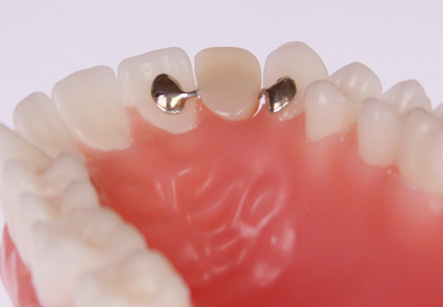Maryland Bridge
Introduction
If a missing tooth is present and if the patient follows good oral as well as dental hygiene practices, the prudent choice for the tooth replacement is a bridge.
A dental bridge is a dental technique of restoration utilized for replacement of missing tooth. It adheres to contiguous teeth or other implants. These bridges prevent dental problems like decay of tooth, speech disturbances and shifting teeth. There are several different types of bridges available depending upon the location of the missing teeth, the condition of the surrounding teeth and choice of the patient.
Purpose of a bridge:
The most essential purpose of fixing a dental bridge is for preventing the contiguous teeth from shifting in a place created by missing teeth. This shifting also causes change of bite, sore jaws and problems in the jaw joint. Such uneven bite makes chewing difficult and can cause a person to grind and clench instead. The teeth opposite to a missing tooth can become loose and sometimes extrude from the place. Missing teeth also compromise dental and oral hygiene causing tooth decay and various gum diseases.
Iran offers a superior Dental treatments that is world best quality. For patients from the USA, and Europe for example, the savings can be 60% or more

Making and uses:
Maryland bridges are made from a special resin bonded to a metal frame having wings and these wings are cemented on to the enamel of the surrounding teeth for holding the bridge in place. The wings are attached using a strong adhesive. The teeth surrounding the gap need not have complete crowns for this bridge. Local anesthetic injection is usually not needed when fitting a Maryland Bridge.
This procedure causes minimal damage to the neighboring teeth and also allows the bridge to be fitted quickly. The exposure of dentin of the surrounding teeth is not required; therefore there is no increase in tooth sensitivity. Maryland Bridges are generally used in case of smaller gaps in the teeth towards the front of mouth.
Procedure
There are several steps in the making of this bridge. First, the dentist examines the teeth and decides that the patient is a candidate for a bridge or not. Once the decision is made, a baseline X-ray film of teeth can be taken. The process goes as given:
• In the first visit, the dentist prepares the teeth on either side of the defect left by a missing tooth. A mild anesthetic medicine is injected to numb the area. Then the cosmetic dentist makes enough space between the teeth on either side so as to accommodate the thickness of the crown. If these teeth already have fillings, they are left in place serving as a foundation for the crown.
• The dentist makes an impression, from which the bridge, false tooth and crowns are made in a dental laboratory. Until the next visit, patient is made to wear a temporary bridge. This temporary bridge protects the teeth and gums till the next visit. Or else, a Flipper appliance is used in the place of missing tooth which can also serve as temporary bridge. A Flipper is a false tooth attached via either a wire or a plastic piece to the roof of the mouth awaiting the permanent bridge.
• On the second visit, the temporary bridge is removed and new permanent bridge is fitted and checked and adjusted for any bite problems. If none, the new bridge is cemented to the teeth permanently.
Maryland Bridge longevity:
A Maryland Bridge can last over ten years if relevant care of it is taken and if good oral hygiene practices are followed.
Advantages:
1. Less damage to contiguous teeth as there is no need to crowning of these teeth in a Maryland bridge.
2. Three is No increase in dental sensitivity as dentin is not exposed.
3. Quick to fit and adjust.
4. Local anesthetic injection is usually not needed when fitting a Maryland Bridge.
Disadvantages:
1. Cost-they are more expensive than a normal bridge due to the process of the fitting and the skill required in fitting a Maryland Bridge.
2. Limited suitability –these bridges are only suitable for people having smaller gaps towards the front of mouth and they cannot be used if the surrounding teeth are damaged.